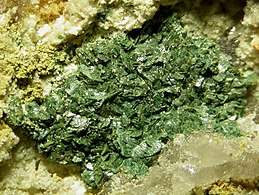| Vauquelinite | |
|---|---|
 | |
| General | |
| Category | Phosphate mineral |
| Formula (repeating unit) | CuPb2(CrO4)(PO4)(OH) |
| IMA symbol | Vql |
| Strunz classification | 7.FC.05 |
| Crystal system | Monoclinic |
| Crystal class | Prismatic (2/m) (same H-M symbol) |
| Space group | P21/n |
| Unit cell | a = 13.754(5) Å, b = 5.806(6) Å c = 9.563(3) Å; β = 94.55°; Z = 4 |
| Identification | |
| Color | Olive-green, apple-green, brown to nearly black |
| Crystal habit | Irregular wedge shaped crystals, mammillary, reniform masses |
| Twinning | Present on {102} |
| Cleavage | Indistinct |
| Fracture | Irregular |
| Tenacity | Brittle |
| Mohs scale hardness | 2.5 – 3 |
| Luster | Adamantine, resinous |
| Streak | Greenish or brownish |
| Diaphaneity | Translucent |
| Specific gravity | 6.16 |
| Optical properties | Biaxial (−) |
| Refractive index | nα = 2.110 nβ = 2.220 nγ = 2.220 |
| Birefringence | δ = 0.110 |
| Pleochroism | X = Light green, Y = Light brown, Z = Light brown |
| 2V angle | Near zero |
| References | |
Vauquelinite is a complex mineral with the formula CuPb2(CrO4)(PO4)(OH) making it a combined chromate and phosphate of copper and lead. It forms a series with the arsenate mineral fornacite.
It was first described in 1818 in the Beryozovskoye deposit, Urals, Russia, and named for Louis Vauquelin (1763–1829), a French chemist. It occurs in oxidized hydrothermal ore deposits and is associated with crocoite, pyromorphite, mimetite, cerussite, beudantite and duftite at the type locality in Russia.
References
- Warr, L.N. (2021). "IMA–CNMNC approved mineral symbols". Mineralogical Magazine. 85 (3): 291–320. Bibcode:2021MinM...85..291W. doi:10.1180/mgm.2021.43. S2CID 235729616.
- ^ Mindat – Vauquelinite
- Webmineral – Vauquelinite
- ^ Handbook of Mineralogy – Vauquelinite
This article about a specific phosphate mineral is a stub. You can help Misplaced Pages by expanding it. |